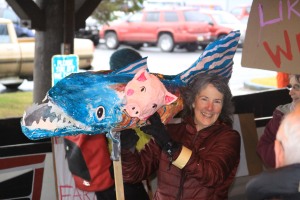
The Alaska Division of Agriculture is excited to announce that it is accepting initial “scoping” applications for the new micro-grants for food security.
The micro-grants program has a two-step application process, with initial scoping applications being submitted first. Then, the top projects from the initial applications submitting a more detailed application before money is awarded this spring. The due date for two-page initial applications is Feb. 15.
The global COVID-19 pandemic reminded Alaskans they live at the end of a long and sometimes tenuous food supply chain. These micro-grants are aimed at strengthening local food security.
“While Alaska enjoys the benefits of a global supply system, it is simply responsible to support home-grown systems we can rely on, just in case,” said David W. Schade, director of the Alaska Division of Agriculture. “We are fortunate to now be able to offer micro-grants aimed at enhancing our ability to be more self-reliant when it comes to necessities like food.”
At the urging of Sen. Lisa Murkowski, the 2018 federal Farm Bill authorized the state to issue micro-grants to support innovative ways to improve Alaska’s food security. The division has begun accepting scoping applications for three-year grants of up to $15,000 for individuals ($5,000 per year), or $30,000 for qualified organizations ($10,000 per year). Individuals and qualified organizations can partner with each other to be eligible for combined funding (for example, if two individuals and an organization partner they would be eligible for $20,000 per year). The U.S. Division of Agriculture will provide $1.8 million to the division in each of the program’s first two years.
“We will prioritize funding of grants for projects that will increase local food production and storage, as well as education efforts to support these local efforts,” Schade said. Qualifying activities may include small-scale gardening, small-scale herding and livestock operations, and/or expanding access to food, safe food storage, and knowledge of food security.
Grant applicants must provide an initial scoping application to the division by Feb. 15. The division will then invite qualifying applicants to submit a full project proposal. Multiple individuals or organizations may submit joint applications for grants to support coordinated activities. The initial scoping application form and deadline information are available online at http://dnr.alaska.gov/ag/ag_grants.htm.
All individual Alaskans and many organizations qualify to apply for these grants, and the division hopes to have a strong batch of applications in the program’s first year. The security of two years of federal funding means projects the division cannot fund in 2021 will have another chance next year, Schade said.
“Alaska will have $1.8 million to help Alaskans grow more nutritious food locally and become more food secure. Individuals are eligible for up to $5,000 grants,” said According to Karen McCarthy, senior legislative assistant for Sen. Murkowski.
“Organizations such as Indian tribes and tribal organizations; non-profits such as religious organizations, food banks and food pantries; federally-funded educational facilities including Head Start and Early Head Start programs, public schools, public institutions of higher education, tribal colleges and Universities, and job training programs; and local and tribal governments that may not levy local taxes under state or federal law will be eligible for up to $10,000 in grant funds. Eligible projects are those that will increase the quantity and quality of locally grown food for food insecure individuals, families, neighborhoods, and communities — a pretty wide-open range of projects that Alaskans’ innovative thinking can really make exciting.”
The website, http://dnr.alaska.gov/ag/ag_grants.htm, includes a variety of information about the program. Click this link for access to a Facebook Live video presentation on Thursday, Jan. 21. Click this link for the PowerPoint slides used during the Facebook Live presentation. Click this link for the two-page scoping application form (which can be filled out online or printed and completed), and click this link for an application guide and instructions. Click this link for a one-page information sheet from Sen. Murkowski’s office about the program. Applications can be submitted by email and by regular mail, but they should be timed to arrive by Monday, Feb. 15.
If you have further questions, please reach out to Catherine Cheadle, the grants specialist who is heading up this program. You can call her at 907-761-3851 or email her at catherine.cheadle@alaska.gov.









You must be logged in to post a comment.